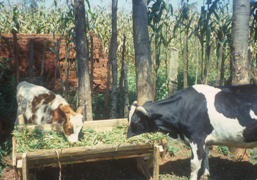 Also called elephant grass, Napier grass is planted on farms across East Africa as a source of feed for dairy cows. Farmers cut the grass for their livestock, carrying it home for stall feeding.
Also called elephant grass, Napier grass is planted on farms across East Africa as a source of feed for dairy cows. Farmers cut the grass for their livestock, carrying it home for stall feeding.
It is the most important forage grass in the region, constituting 40 to 80% of forages used by smallholder dairy farmers. In Kenya, half a million smallholder dairy producers rely on Napier grass to feed their cows. In Uganda, 90% of farmers rely entirely on Napier grass as fodder for their improved dairy cattle.
The livelihoods of these farmers are threatened by outbreaks of stunt and smut diseases affecting the Napier grass. To tackle the threat, the Association for Strengthening Agricultural Research in Eastern and Central Africa (ASARECA) funded a three-year project to determine the extent of the disease problem, to collect disease-resistant Napier grass clones identified by farmers, and to identify best management practices used by farmers to mitigate the impact of the diseases.
After three years researching the problem in Kenya, Tanzania and Uganda, project researchers from the International Livestock Research Institute, Rothamsted Research, the Kenya Agriculture Research Institute, the National Agricultural Research Organisation (Uganda) and the National Biological Control Programme (Tanzania) will meet with colleagues from the region to share results and recommendations, promote good practices and draw other scientists into the project.
The workshop will be held at ILRI Ethiopia from 1 to 3 June, 2010.
More information:
